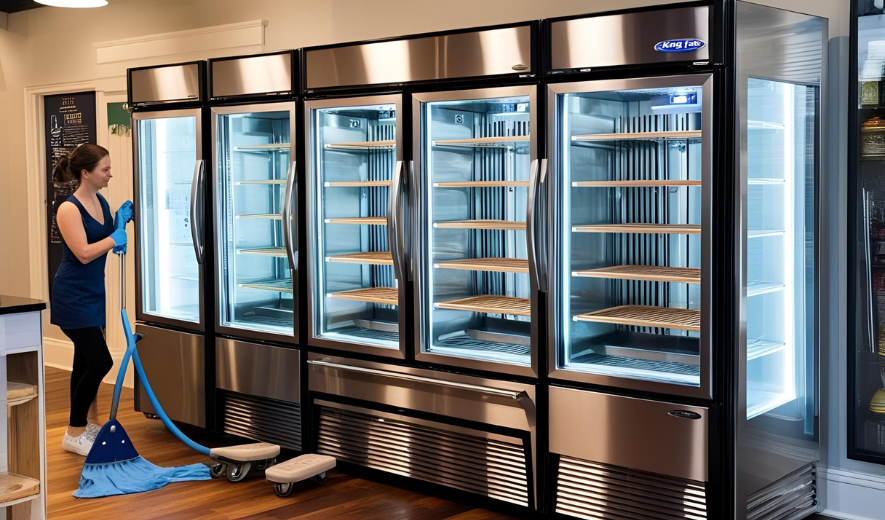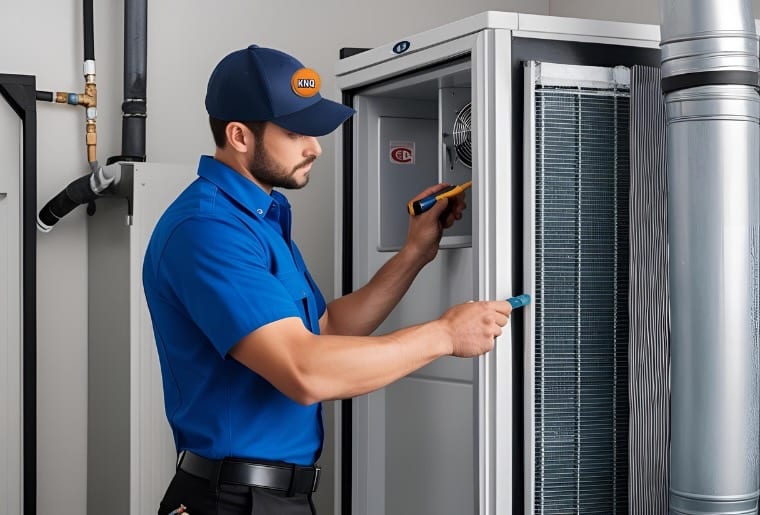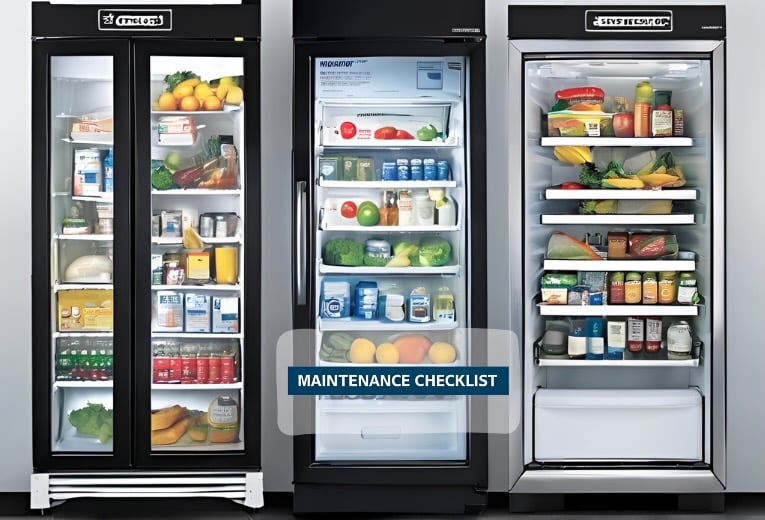Free delivery. Terms and Conditions apply.

Whether you’re running a busy hawker kitchen, managing a cold display in a convenience store, or operating a central kitchen in Changi, your commercial refrigerator is one of your most valuable assets. When maintained properly, it preserves food safety, ensures energy efficiency, and keeps operations running smoothly. But in Singapore’s humid climate and high-demand foodservice environment, even the best commercial units need regular attention. In this guide, you’ll learn step-by-step cleaning techniques, essential maintenance practices, and how to know when it’s time to call in a professional—all tailored to Singapore’s food and retail businesses.
Keeping your commercial refrigerator clean is not just about appearances—it’s a core part of maintaining hygiene, food safety, and energy efficiency. In Singapore’s warm and humid environment, where condensation builds up quickly and food turnover is high, bacteria, mold, and odours can develop in a matter of days. A neglected fridge can quickly become a health hazard, a source of customer complaints, or even a failed inspection under SFA guidelines.
Before you begin cleaning, one key question arises:
What Do You Need to Know Before Cleaning Your Commercial Fridge?
Before grabbing a sponge or disinfectant, there are several important considerations to keep in mind:
Yes, but only with caution. Bleach must be diluted (usually 1 tablespoon per litre of water) and used only on non-porous, non-food-contact surfaces. After using bleach, make sure to rinse thoroughly with clean water and wipe dry to prevent any lingering odour or chemical residue.
Even brand-new commercial refrigerators can contain dust, plastic residue, or manufacturing oils. Before using it, wipe down all internal surfaces with warm, soapy water, followed by a rinse with clean water. Avoid harsh chemicals on the first cleaning.
Now that the basics are covered, we’ll break down how to clean specific commercial fridge types based on their design and use.
Commercial display refrigerators are widely used across supermarkets, cafes, and convenience stores. These units are designed to showcase chilled goods like beverages, cakes, seafood, or ready-to-eat meals. Because of their visibility and customer-facing function, both cleanliness and clarity are crucial—not just for hygiene but also for aesthetics and product appeal.
There are several types of commercial display refrigerators commonly found in Singaporean businesses:
Each of these models has a different airflow pattern, drainage system, and layout—which means cleaning steps should be tailored accordingly.
Step-by-Step: Cleaning Techniques for Display Refrigerators

The process is similar to cleaning a display fridge: remove items, clean interior surfaces with warm soapy water, disinfect, and pay special attention to the condenser and evaporator coils. Chillers may also require more frequent drainage checks due to condensation build-up in Singapore’s high-humidity environment.
Use a food-safe sanitising spray or a vinegar-water solution (1:1 ratio) to kill bacteria after the initial cleaning. Focus on handles, shelf edges, and door seals—areas that come in frequent contact with hands or food packaging.
Ideally, shelves and visible surfaces should be wiped daily. A full deep-clean including coils and drain systems should be done every 1–2 weeks, depending on usage. In Singapore’s climate, businesses with high customer traffic may need to clean more frequently.
Freezers play a vital role in preserving food quality and safety by maintaining consistently low temperatures. In Singapore’s humid and warm environment, proper cleaning of freezers is essential to avoid ice buildup, bacterial growth, and energy inefficiency. Commercial freezers commonly come in two main types: chest freezers and upright freezers. Each has distinct designs and operational features, requiring slightly different cleaning approaches.
Chest freezers are typically used for bulk frozen goods and often have a top-opening lid. Upright freezers resemble refrigerators with front-opening doors and multiple shelves inside, ideal for organized storage of various frozen products.
A key distinction in freezers is between auto-defrost and manual defrost models. Auto-defrost freezers periodically melt away frost automatically, reducing the need for frequent manual defrosting. Manual defrost freezers require owners to turn off the unit and let ice melt before cleaning, which can take several hours.
How to Clean Auto-Defrost Freezers?
Auto-defrost freezers are generally easier to maintain because frost buildup is minimal. Still, regular cleaning is necessary:
How to Clean Manual Defrost Freezers?
Manual defrost freezers require extra attention:
Door gaskets are critical for maintaining airtight seals and preventing cold air leakage, which can increase energy use and frost buildup. Check gaskets monthly for cracks, tears, or warping. Generally, replacement every 1–3 years is recommended depending on usage intensity.
For freezers, a thorough cleaning and defrosting should be conducted at least once every 3 months for manual defrost units. Auto-defrost freezers may be cleaned more frequently, with a full interior wipe-down and coil cleaning every 1–2 months recommended to maintain efficiency and hygiene in Singapore’s tropical environment.
Undercounter refrigerators are compact cooling units designed to fit neatly beneath countertops, making them popular choices for cafes, bars, and small kitchens in Singapore where space optimization is essential. Despite their size, these units require regular cleaning to maintain hygiene, efficiency, and longevity.
Because undercounter refrigerators often have front ventilation and are located in tight spaces, their cleaning process needs to address airflow restrictions and prevent dust accumulation which can strain the compressor.
Step-by-Step Cleaning Method for Undercounter Refrigerators:
How Often Should a Commercial Refrigerator Be Cleaned?
For undercounter refrigerators, a basic cleaning of interior and exterior surfaces is recommended weekly. Coil and drainage system cleaning should be performed monthly to maintain optimum performance.

Walk-in refrigerators are large refrigerated rooms designed for high-volume storage, commonly used by restaurants, hotels, supermarkets, and catering businesses across Singapore. Due to their size and complexity, walk-in coolers require a specialized cleaning approach to ensure food safety, efficient operation, and compliance with local health regulations.
Because walk-in cold rooms hold large quantities of perishables and have multiple refrigeration components, proper cleaning is essential to avoid mold, bacteria growth, and system inefficiencies. The scale and technical nature of these units mean that professional maintenance services are often the best option to ensure thorough and safe cleaning.
Step-by-Step Cleaning Method for Walk-In Coolers:
Given the size, technical complexity, and regulatory standards around commercial walk-in coolers, professional cleaning services provide the expertise and equipment necessary for effective sanitation and maintenance. Professionals can perform deep coil cleanings, diagnose mechanical issues, and ensure that your cooler operates efficiently, reducing downtime and costly repairs.
While bleach is a powerful disinfectant, it is not recommended for cleaning commercial refrigerators or walk-in coolers as it can corrode metal surfaces and leave harmful residues. Instead, use food-safe sanitizers approved by the Singapore Food Agency (SFA).
For walk-in coolers, daily spot cleaning of spills and weekly cleaning of floors and shelves is ideal. A deep cleaning, including coil and drain system maintenance, should be scheduled at least quarterly, with professional service recommended biannually or annually depending on usage.
Keeping commercial refrigerators clean is critical not just for operational efficiency but also for health, safety, and regulatory compliance. Dirty refrigerators can become breeding grounds for bacteria, mold, and unpleasant odors, risking food contamination and spoilage. For business owners in Singapore’s food and retail sectors, maintaining pristine refrigeration units is essential to uphold food safety standards, protect your investment, and ensure customer satisfaction.
The Singapore Food Agency (SFA) and the U.S. Food and Drug Administration (FDA) emphasize the importance of regular cleaning and maintenance of commercial refrigeration equipment to prevent cross-contamination, preserve food quality, and reduce the risk of foodborne illnesses. According to SFA guidelines, refrigeration units must be kept clean, free of mold, and operating at the right temperature ranges to prevent bacterial growth.
Regular cleaning improves energy efficiency by allowing the refrigeration system to work without obstructions caused by dust, ice buildup, or dirty condenser coils. This helps lower electricity consumption and extends the lifespan of the appliance. Neglecting cleaning can lead to mechanical breakdowns, costly repairs, and unexpected downtime, which can severely disrupt business operations.
Moreover, frequent cleaning reduces the risk of non-compliance penalties during health inspections. Singapore’s stringent food hygiene regulations require businesses to demonstrate proper storage and handling of perishable goods, and clean refrigeration units are a critical part of this compliance.
Maintaining a clean commercial refrigerator is a proactive step every Singaporean business owner should prioritize to protect public health, optimize equipment performance, and safeguard their brand reputation.
Preventive maintenance is essential for keeping your commercial refrigerator running smoothly and avoiding costly breakdowns. In Singapore’s warm and humid climate, refrigeration units work harder, making regular upkeep even more important. Proactive care not only extends the lifespan of your appliance but also ensures energy efficiency, consistent cooling performance, and food safety compliance.

Regular maintenance helps identify small issues before they escalate into major problems. It reduces unexpected downtime that can disrupt your business and increase operational costs. Taking scheduled preventive steps means fewer emergency repairs, optimized energy consumption, and better protection of your valuable inventory.
Even with diligent cleaning and maintenance, there are times when commercial refrigerator owners should seek professional help to ensure the equipment continues to operate safely and efficiently.
Signs You Should Call a Professional:
Professional Tips for Refrigeration Equipment Longevity:
Regular professional inspections and servicing are vital to catch hidden issues and maintain optimum performance. Experienced technicians can recharge refrigerant, replace worn components, calibrate thermostats, and clean hard-to-reach parts like condenser and evaporator coils.
Singapore’s tropical climate puts extra strain on refrigeration systems, so scheduling biannual or annual professional check-ups is a smart investment for business owners looking to avoid costly repairs and operational downtime.
Moreover, many service providers, such as KnQ Fatt Refrigeration, offer tailored maintenance plans that ensure timely servicing and priority response when emergencies arise — a valuable safeguard for busy restaurants, retailers, and commercial kitchens.
KnQ Fatt Refrigeration is recognized as one of Singapore’s premier commercial refrigeration providers, trusted by restaurants, supermarkets, food retailers, and commercial kitchens across the island. With years of experience serving the unique demands of Singapore’s food industry, KnQ Fatt specializes not only in supplying high-quality commercial refrigerators but also in professional repair and maintenance services.
Whether you operate a walk-in cooler, commercial display fridge, undercounter refrigerator, or freezer, KnQ Fatt’s team of certified technicians offers comprehensive servicing to keep your equipment running smoothly. Their expert services include timely repairs, preventive maintenance, refrigeration system diagnostics, and emergency breakdown support — all tailored to the fast-paced business environments of Singapore.
Beyond repairs, KnQ Fatt provides end-to-end support for your commercial kitchen appliances, helping businesses save costs by extending equipment lifespans and improving energy efficiency. Their commitment to excellence, prompt service response, and in-depth technical knowledge make them the go-to partner for commercial refrigeration solutions.
In Singapore’s food and beverage industry, commercial refrigerators play a crucial role in maintaining food safety, freshness, and compliance with local regulations. A minor cooling issue or faulty seal can quickly turn into a costly problem — leading to product spoilage, downtime, and even non-compliance with Singapore Food Agency (SFA)
A malfunctioning commercial refrigerator can disrupt operations, compromise food safety, and lead to costly inventory losses—especially in Singapore’s heat and humidity. Whether you’re noticing unusual noises, fluctuating temperatures, or excessive frost buildup, knowing the warning signs of refrigerator failure is essential. In this guide, we break down everything you need
Commercial refrigerators are essential for businesses in the food, medical, and retail industries, ensuring that perishable goods remain fresh and safe. However, maintaining the right temperature is crucial for food safety, energy efficiency, and equipment longevity. In this guide, we’ll cover ideal temperature settings, how to maintain them, common temperature
Choosing the right commercial freezer can make a significant impact on your business operations—whether you’re running a busy restaurant in Bugis, managing a 24-hour convenience store in Bedok, or stocking up perishables for your catering service in Jurong. In Singapore’s competitive F&B and retail landscape, refrigeration isn’t just about cooling—it’s
When it comes to running a successful business in Singapore’s food and beverage (F&B) sector, floral supply industry, or restaurant operations, choosing the right refrigeration unit is more than just a matter of storage—it’s a decision that directly affects food quality, customer satisfaction, and energy consumption. Business owners often face

For many businesses in Singapore—whether you’re running a bustling restaurant, a cozy florist shop, or a convenience store—finding the right refrigeration unit is a decision that directly impacts operations. While the options seem endless, two of the most commonly used units in commercial settings are upright refrigerators and undercounter refrigerators.